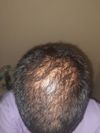community 3 months progress with Finasteride 0.5mg/daily, Minoxidil foam5% 2x daily, Stemoxydine 2x daily, Microneedling(M8) 1.5mm 1x per week, Saw Palmetto 400mg/day, peppermint and jojoba oils daily, Ketoconazole 2% shampoo 3x/week, Purador shampoo/conditioner every day.
Jordan-Iliad has been using a combination of finasteride, minoxidil, stemoxydine, microneedling, saw palmetto, peppermint and jojoba oils, ketoconazole shampoo, and Purador shampoo/conditioner for 3 months to treat their hair loss with stunning results. They have also recently started taking oral minoxidil 1.25mg/day in hopes of achieving even better results over the next 3 months.
